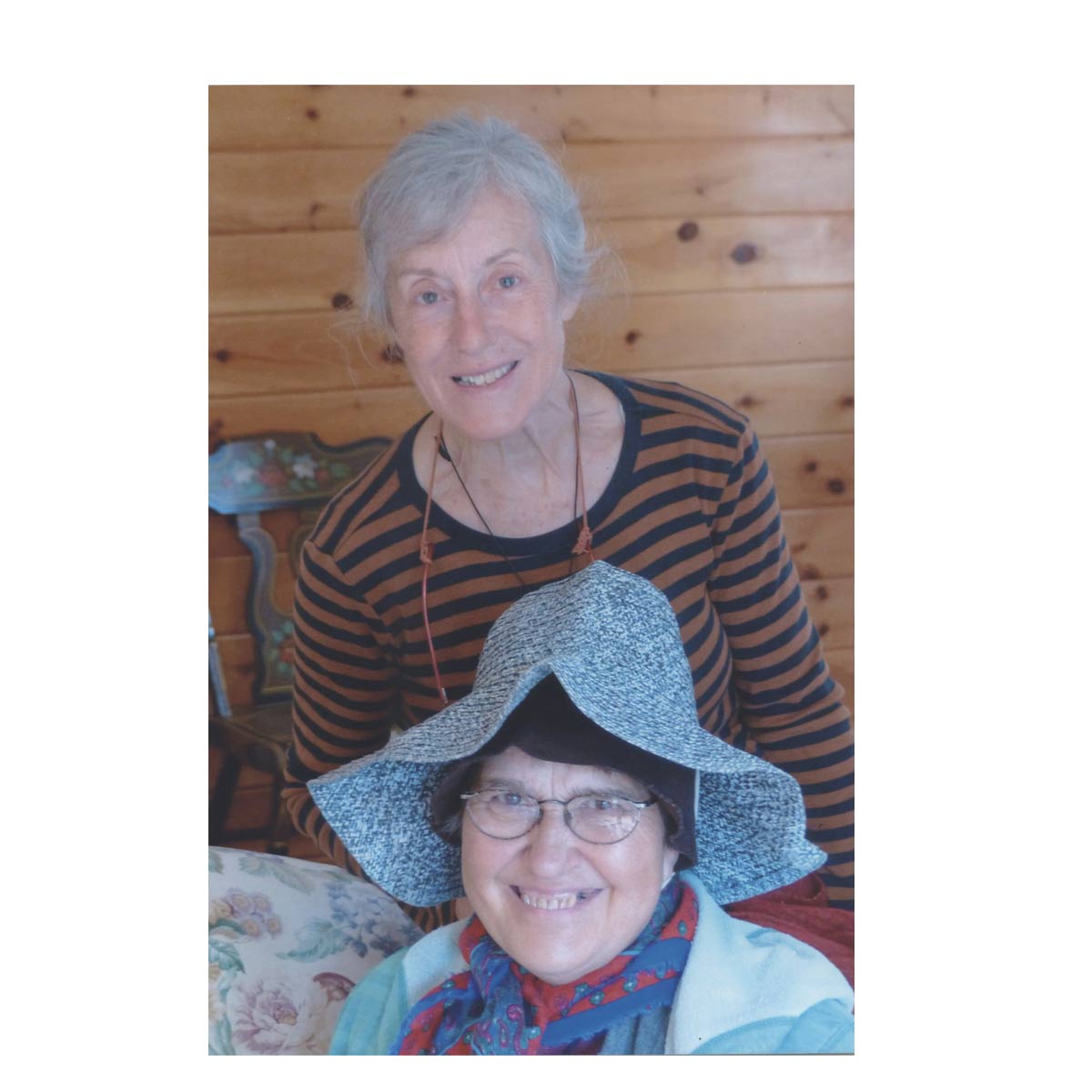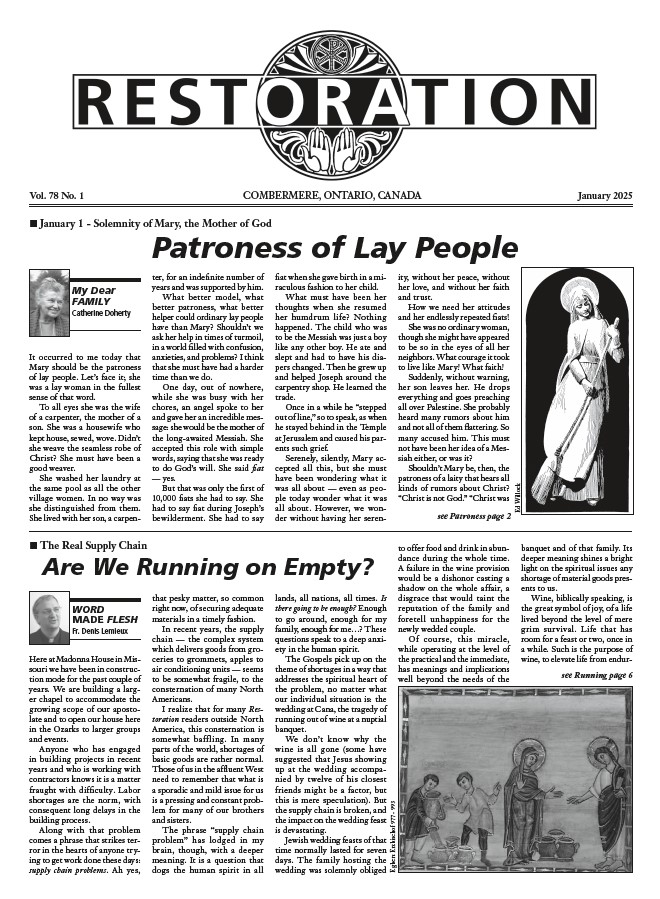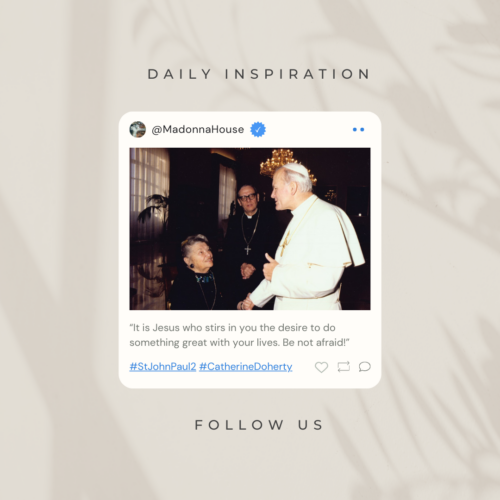This content has been archived. It may no longer be relevant
Here in Madonna House our foundress Catherine Doherty told us a lot about pilgrimage, and much of what we heard can now be found in her books. It can be found in My Russian Yesterdays and Not Without Parables but especially in Strannik (the Russian word for pilgrim), which is a whole book about pilgrimage.
However, her most powerful words about pilgrimage can be found in her poem, “Journey Inward,”* which is about the hunger within each of us to encounter God.
I have made five walking pilgrimages, and the purpose of each one was: “Each step for the glory of God, for the conversion of my own soul and the souls of others.”
When did I first get the idea of going on a walking pilgrimage? On the Feast of Our Lady of Combermere, June 8, 2002, I went early in the morning to her statue hoping to be the only one there. Instead I met my neighbour and friend, Sheila O’Brien, who had also come hoping to be alone.
We started talking, and somehow we ended up with the idea of doing a walking pilgrimage from Our Lady of Combermere to the Shrine of the Canadian Martyrs in Midland, Ontario.
I thought that was a great idea, but because of his concerns about my physical safety, my spiritual director did not agree. He told me not to talk about it for the next four years.
In the end, he consented to a lesser distance: from Our Lady of Combermere to the pilgrim statue of Our Lady of the Cape in Ottawa—200 km (124 miles) away. And it was with Lois Losole, another friend and neighbour, not Sheila O’Brien, that I went.
Early on the morning of October 1, 2008, the Feast of St. Thérèse of Lisieux, Lois and I went to the statue of Our Lady of Combermere. We prayed the Prayer for the Travelers and the Prayer to Our Lady of Combermere. Then we were off.
We walked out of the village of Combermere, taking the bridge across the Madawaska River, and then went on Rockingham Road. This took us into an isolated area with no houses—up and down steep hills and through wooded areas and marshes. Then we came to flat area.
Far ahead of us we saw a big light-colored animal, which was slowly walking towards us, grazing as it came.
Lois said, “Maybe it is a bull!”
I said, “Oh, Lois, it can’t be a bull. There are no farms close by.” We decided to pray a Hail Mary for protection.
Lois said, “We could climb a tree.”
I said, “I am too old and fat.” Besides, the trees around us were relatively short—balsam fir, and tamarack, trees with many small branches, not suitable for fast and high climbing.
The animal kept coming, and now we could see that it was a huge Charlois bull. Suddenly, the bull spied us, fixed his eyes on us, and started to trot towards us.
At the same time a small compact car came down the hill behind the bull and passed him. I planted myself in the middle of the road, arms thrown wide with my walking stick out so the car couldn’t pass us.
I shouted to the astonished elderly gentleman who was driving that we needed to get in his car and quickly. The back seat was full of tools and the passenger bucket-seat full of papers. He quickly threw the papers in the back seat while I sat down in the bucket seat.
“Where can I sit!” Lois exclaimed.
I said, “Sit on my lap!”
She did so and her feet were so close against the door that we couldn’t shut it. With the door still open, the driver quickly pulled away.
He heeded our instructions that we needed to be taken past the bull. He found a place to turn around and drove us back past the bull to a safe enough distance for us to continue our pilgrimage.
Lois and I have never forgotten that close encounter with the bull. We prayed about the meaning of it, and it seemed to us that the Evil One would have liked to destroy us but God protected us.
Facing that life-threatening situation on that first morning of my first walking pilgrimage showed me how much a pilgrimage is a spiritual battleground and how much God wanted the pilgrimage to take place.
Here is the prayer of St. John de Brébeuf, the early Canadian missionary martyr, a prayer I have prayed on all my walking pilgrimages: “My God, it grieves me greatly that you are not known, that in this savage wilderness all have not been converted to you, that sin has not been driven from it.”
Ever since that first pilgrimage, what has given me courage to walk again is what happens between me and the people I meet.
One afternoon when my water bottle was empty, we stopped by a house where several teenage boys were working on their car. They not only filled my bottle with water—after offering me a beer—but I ended up praying a prayer of blessing with them and some teenage girls.
Because we beg for a home to stay at, food to eat, and transportation for our packs, we encounter people’s great love and generosity to us.
A young boy asked, “Do you feel the glory of God with each step?”
I replied, “No, I just feel the walking of my feet. But it is in the meeting of people, like when I am talking to you, that I see the glory of God”.
Around 3 p.m. each day we pray the Chaplet of Divine Mercy: “Have mercy on us and on the whole world” is the cry in our hearts as we walk along. We also pray a rosary and at noon, the Angelus.
Really, pilgrimage is about conversation with God as we walk along. We pray for a place to sit down, eat, rest, and go to the bathroom. We pray for safety as we walk. We pray for those we meet along the way.
To be on pilgrimage is to trust in the care of God the Father. It is to share the Good News of Jesus Christ. It is trusting in the guidance of the Holy Spirit to find who we should meet and what we should communicate.
It is trusting that any weather we have is the right weather. Any weather is good weather, for a pilgrimage is not about comfort. And it is not a marathon.
And what time we start and stop walking depends on the activities of our host.
In 2016, the Jubilee Year of Mercy, the year in which the Holy Father decreed that an indulgence be given for walking through the Holy Doors, I had been given permission to walk from Our Lady of Combermere to the Holy Door at the Cathedral of St. Columbkille in Pembroke, our diocesan seat, 100 km. (62 miles) away.
Not long after that, I received an invitation to join a pilgrimage to Europe by airplane.
When I asked Susanne Stubbs, our director general of women, what I should do, she told me to keep the Pilgrimage to the Holy Doors in Pembroke.
As I prayed about it, it seemed like God’s idea was that he had plenty of people willing to fly to Europe, but he didn’t have many others who were foolish and little enough to walk from Our Lady of Combermere to the cathedral in Pembroke.
My fifth and most recent pilgrimage was in October 2018 with Wendy Zakrzewski, another friend and neighbor, from the Martyrs’ Shrine in Midland to Our Lady of Combermere.
Just before we began, I woke up at 12:30 a.m. with the throbbing of a sore toe. As I sat in our living room with my foot in a basin of Epsom Salts, I thought, “How foolish can I be! I am 74 yrs old, planning to walk 250 km, and now my toe is sore! Maybe I won’t even be able to walk for one day!”
Then I looked in my travel bag, and I saw a sheet of paper I had put there two years earlier. It was Fr. Dolindo’s “Novena of Surrender to the Will of God,” which is about committing everything to God and not worrying about anything.
I started to laugh. “God, I sure hope you know more about this pilgrimage than I do,” I told him. And he did.
Every time I planned and started on my five walking pilgrimages, I felt foolish and afraid of being foolish. After all, I always beg for a place to stay, food to eat, the transportation of my luggage and someone to pick me up along the route.
Sometimes I ask someone I know, and sometimes I am a stranger depending on the good will of strangers I have only met by telephone.
“Hello, I am Alma Coffman, a member of Madonna House, Combermere, and I am walking on pilgrimage with another woman, and we need a place to stay…..”
In order to go on pilgrimage as a member of Madonna House I need three permissions, from the local director of the mission I am in, the director general of women, and my spiritual director.
In February 2018, when I received my letter of permission from my director general for my most recent pilgrimage, I was lying on the couch in St. Joseph’s House sick with the flu. Right then I was so weak I couldn’t get up for more then ten minutes without collapsing. Did I really think I could walk 250 km?
Sometimes I have pilgrimaged alone, but if I have a companion, it is a great encouragement.
The Psalms also give me lots of courage. Blessed are those whose strength is in you, in whose hearts are the highways to Zion (Psalm 84:2).
And when I am tired, this one seems so appropriate, Why are you cast down my soul and why are you disquieted within me? Hope in God; for I shall again praise him, my help and my God. (Psalm 42:11).
I have walked on pilgrimage five times. Each time I have started from some holy place designated by the Church as blessed and holy and ended at another holy blessed place. (The statue of our Lady of Combermere has been so designated.)
Why do I walk on pilgrimage? As I said at the beginning of this article: for the glory of God, for the conversion of my soul and the souls of others. … And because I have feet.
*See Restoration, February 2019, online at new.madonnahouse.org/restoration





